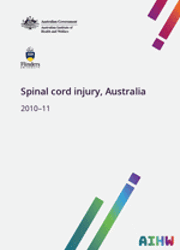Summary
This 12th report in the Spinal cord injury, Australia series presents national statistics on spinal cord injury (SCI) using data from case registrations to the Australian Spinal Cord Injury Register (ASCIR) for 2010–11.
A total of 387 new cases of SCI were reported in 2010–11, with 269 cases resulting from trauma and 118 from other non-traumatic causes.
The age-standardised rate of persisting SCI from traumatic causes for Australian residents (excluding those who died before discharge) was estimated to be 14.3 new cases per million population aged 15 and older.
Persisting traumatic SCI incidence rates for Australian male residents tended to decrease with age while the opposite was true for Australian female residents in 2010–11. The greatest disparity between the sexes was in the 15–24 year age category, with a male: female ratio of 11.9:1. The overall incidence rate for men was 23.0 per million population compared with 5.6 for women, a male:female ratio of 4.1:1.
Persisting traumatic spinal cord injuries were most frequent in the 15–24 aged category (21%). The mean age at injury for male residents was 41, while the mean age for female residents was higher at 50.
The median length of stay in a participating spinal unit (SU) for Australian residents discharged alive with a persisting traumatic SCI was 130 days.
Causes of spinal cord injury
Land transport crashes (43%) were the leading mechanism of injury for cases of traumatic SCI sustained in 2010–11, followed by Falls (35%).
Equal numbers of male Motor vehicle occupants sustained a traumatic SCI in 2010–11 as did male Unprotected land transport users (48 cases, respectively). Seventeen female Motor vehicle occupants made up the remainder of cases due to Land transport crashes.
Similar proportions of Falls from a height greater than 1 metre (18%) and Low falls or falls from an unspecified height (17%) were recorded for 2010–11. Three traumatic SCI cases in 2010–11 involved a High fall while parachuting or abseiling. A further 4 Falls cases involved a fall while snowboarding and 2 cases involved a fall from a trampoline; these cases were not confined to either Falls category. While most Falls were recorded as being Unintentional (that is, accidents) or intent was unknown, cases due to an Adverse effect or complication of medical or surgical care, Assault and Intentional self-harm were also reported.
Other reported mechanisms of injury for traumatic SCI recorded in 2010–11 include Water-related events (5%), Heavy falling objects (3%), Horse-related events (4%), and Football, or more specifically, rugby (1%). Nine per cent of cases were due to Other or unspecified causes including post-operative complications, other forms of transport including water, air and rail, and violence-related causes.
Approximately 1 in 3 traumatic SCI cases reported to ASCIR in 2010–11 were sustained while the person was Engaged in sports or leisure (36%) and the majority (87%) of these were males. Injuries sustained while Working for income (including travel to and from work) accounted for 13% of traumatic cases for this reporting period.



